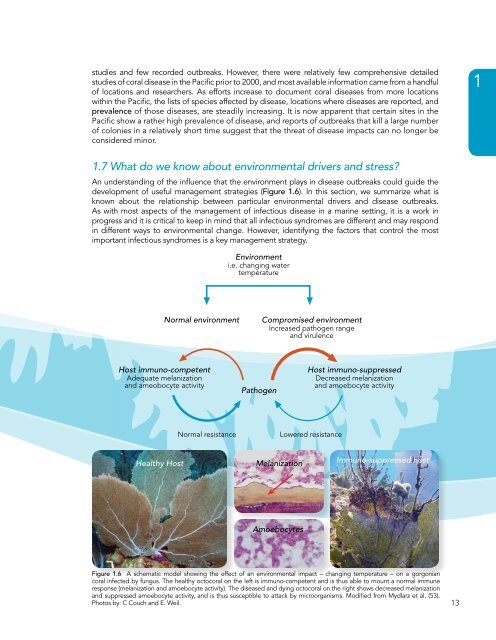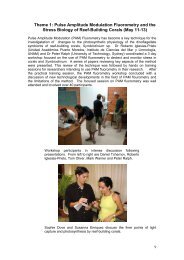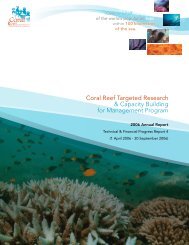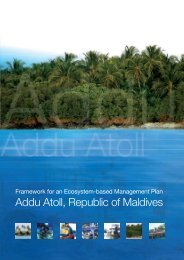A <strong>Coral</strong> <strong>Disease</strong> <strong>Handbook</strong>:Guidelines for Assessment, Monitoring and ManagementWhite plague II White band II White pox* Aspergillosis Bacterial bleachingDiploria Acropora Acropora Gorgonia Oculinalabyrinthiformis cervicornis palmata ventalina patagonicaAurantimonascoralicida(bacterium)Vibrio carchariae(bacterium)Serratia marcescens 1(bacterium)Aspergillus sydowii 2(fungus)Vibrio coralliilyticus(shown) andV.shiloi (bacterium)Figure 1.4 The five coral diseases for which Koch’s postulates have been fulfilled, showing disease, host coral and microbialpathogen. The classic way to prove a microorganism causes disease is to satisfy Koch’s postulates. A microorganism must beisolated from a diseased individual. That “isolate” is then used to infect a healthy individual. The same disease must develop,and the same organism must be isolated from the new infection. This classic method is a tough challenge in the face ofunculturable marine microorganisms and polymicrobial syndromes, requiring molecular approaches.*Originally named white pox, but field signs for this disease are now termed “white patch disease”; this name will be used inthis book.1source: http://commtechlab.msu.edu/sites/dlc-me/zoo/microbes/serratia.html2source: http://www.cdc.gov/ncidod/dbmd/mdb/images/aspergillos.JPGHarvell et al. (26). Photos by: A. Bruckner and E. Weil.The last decade has been a time of intense research into causative agents of coral disease. Thoughwe still lack evidence showing the origin of any coral disease, the role of specific pathogens in causingvarious diseases, their pathogenesis, and agent-host interactions, significant progress is being made in allof these areas. Some infectious agents that cause disease in marine animals, such as that of aspergillosisof octocorals (Figure 1.5) and toxoplasmosis in sea otters, are thought to originate on land.Figure 1.5 Caribbean sea fan Gorgonia ventalinawith multiple aspergillotic lesions. Photo: E.WeilOthers, such as viruses inadvertently introduced fromshrimp or abalone farms to wild populations (McCallum,pers. comm.), originate in aquaculture farms (16). Trackingthe origins of pathogenic agents might reveal sources thatcan be controlled before being introduced into the ocean.For example, Serratia marcescens is a ubiquitous bacteriumintroduced into coastal waters via sewage that may be thecause of white patch, a disease that affects Acroporapalmata (52). There is a very real risk, therefore, that humanactivities may inadvertently introduce environmentalstressors and potential pathogens to marine communities,and will continue to do so unless our understanding ofsuch dynamics improves.121.6 What are the global patterns and where are the hotspots?The Caribbean has been referred to as a “hot spot” for disease because of a rapid emergence of new,extremely virulent diseases, increased frequency of epizootic events, and rapid spread of emergingdiseases among new species and regions. At least 82 percent of coral species in the Caribbean arehost to at least one disease (21).In the Pacific, the threat of coral diseases has been regarded as minor, due to the large distancesbetween reefs and island nations, fewer potential sources of pathogens, a paucity of epizootiological
studies and few recorded outbreaks. However, there were relatively few comprehensive detailedstudies of coral disease in the Pacific prior to 2000, and most available information came from a handfulof locations and researchers. As efforts increase to document coral diseases from more locationswithin the Pacific, the lists of species affected by disease, locations where diseases are reported, andprevalence of those diseases, are steadily increasing. It is now apparent that certain sites in thePacific show a rather high prevalence of disease, and reports of outbreaks that kill a large numberof colonies in a relatively short time suggest that the threat of disease impacts can no longer beconsidered minor.11.7 What do we know about environmental drivers and stress?An understanding of the influence that the environment plays in disease outbreaks could guide thedevelopment of useful management strategies (Figure 1.6). In this section, we summarize what isknown about the relationship between particular environmental drivers and disease outbreaks.As with most aspects of the management of infectious disease in a marine setting, it is a work inprogress and it is critical to keep in mind that all infectious syndromes are different and may respondin different ways to environmental change. However, identifying the factors that control the mostimportant infectious syndromes is a key management strategy.Environmenti.e. changing watertemperatureNormal environmentCompromised environmentIncreased pathogen rangeand virulenceHost immuno-competentAdequate melanizationand ameobocyte activityPathogenHost immuno-suppressedDecreased melanizationand amoebocyte activityNormal resistanceLowered resistanceHealthy HostMelanizationImmuno-suppressed hostAmoebocytesFigure 1.6 A schematic model showing the effect of an environmental impact – changing temperature – on a gorgoniancoral infected by fungus. The healthy octocoral on the left is immuno-competent and is thus able to mount a normal immuneresponse (melanization and amoebocyte activity). The diseased and dying octocoral on the right shows decreased melanizationand suppressed amoebocyte activity, and is thus susceptible to attack by microorganisms. Modified from Mydlarz et al. (53).Photos by: C Couch and E. Weil.13








